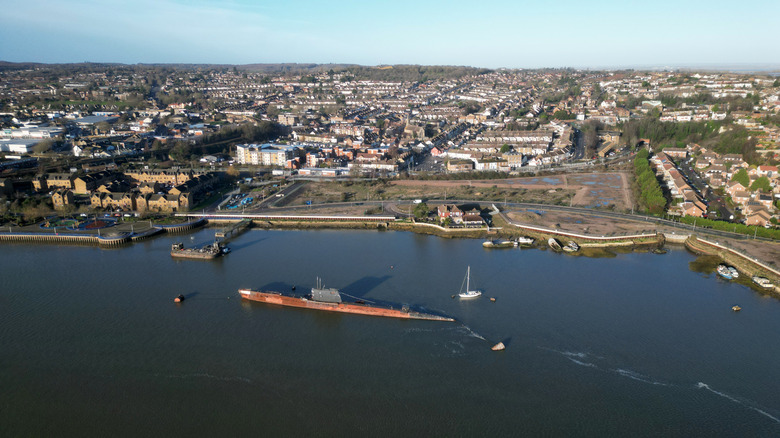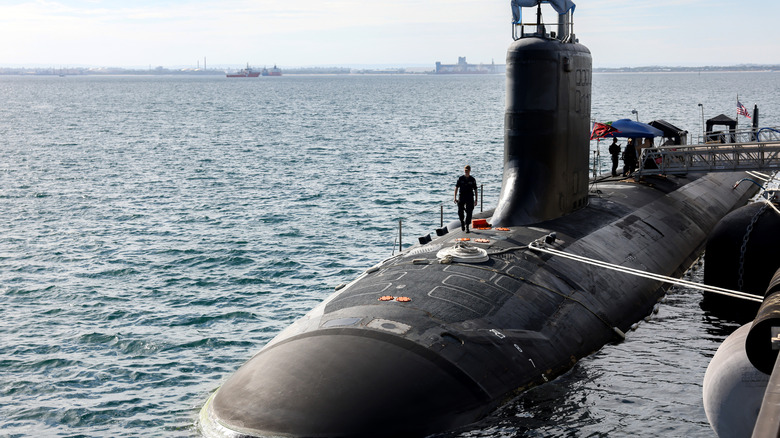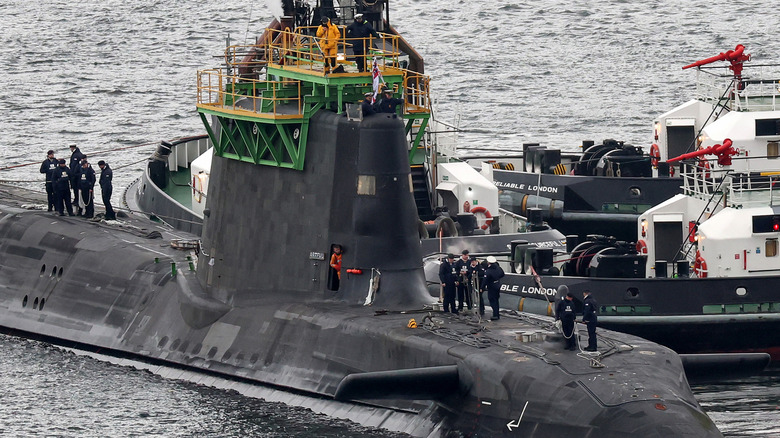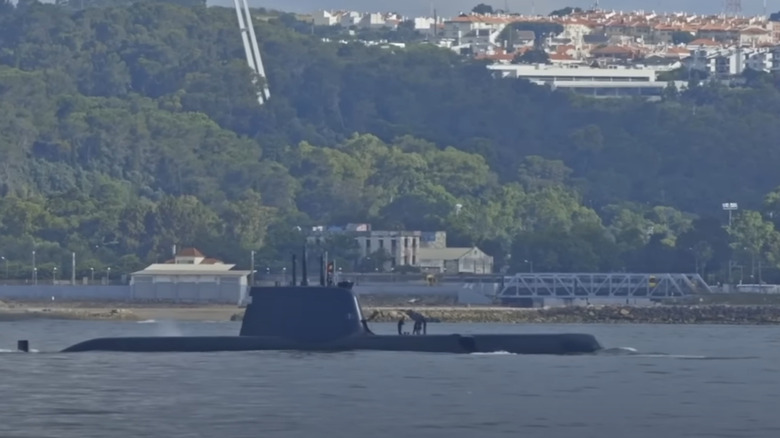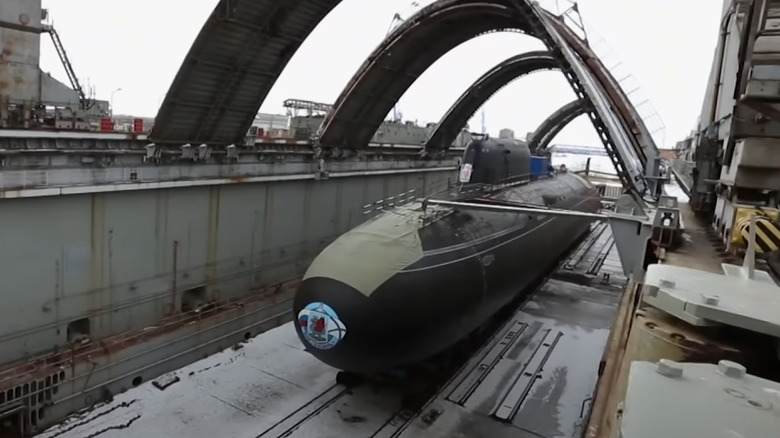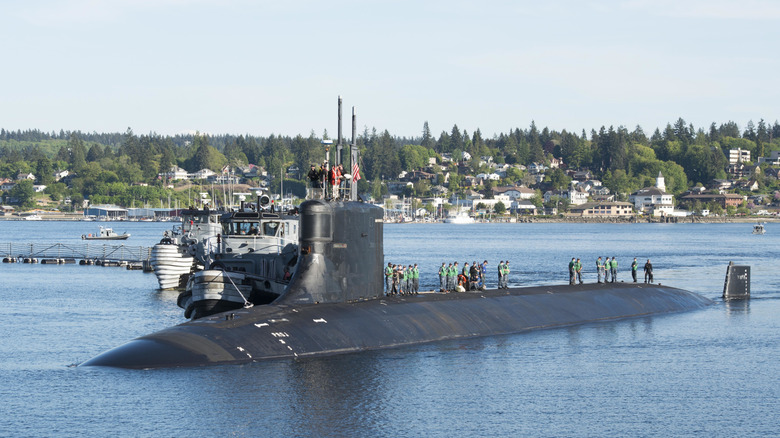5 Of The Fastest Operational Military Submarines In The World
There are four key metrics that a submarine has: crew capacity, weaponry payload, deployment period (how long it can remain submerged), and of course, its speed. And while the first three measurements are fairly watertight — pun intended — measuring the speed of a submarine is actually a lot more complicated than you might think. What makes modern submarines truly terrifying isn't just their stealth (some military subs can go as deep as 1,000 meters) or firepower, but their speed. These aren't the lumbering metal whales of World War II. Today's submarines can move through water faster than most surface vessels. And, when discussing submarine velocity, we're actually dealing with two entirely different speeds.
First up, we have the "surface speed" — this is how fast they move while bobbing about like oversized bath toys on the surface — and this measure is largely irrelevant because modern submarines spend most of their time at depth. Indeed, some military submarines can spend up to 120 days submerged, so the speed that most people quote will be the "submerged speed". Now, submarine speed measurement itself involves two primary methods. The first calculates distance moved relative to fixed land points. It's essentially GPS tracking for underwater vessels. The second uses knots, which is the maritime standard that measures nautical mph. Both methods can yield different results depending on current, depth, and operational conditions. Here are the five fastest operational military submarines currently prowling the world's oceans.
Virginia Class - United States - 25 knots
First up, we have our homegrown Virginia class vessels — some of the most capable, versatile, efficient, and frankly terrifying submarines ever. This class replaced the Los-Angeles class vessels that entered service more than 50 years ago, in 1974. What an upgrade they are. Virginia class subs have a top speed of 25 knots (29 mph), displace 10,200 tons (20.4 million pounds), are 114.8 meters (377 feet) long, and carry an impressive 17 officers, 128 enlisted personnel, tomahawk missiles and Mk 48 advanced torpedoes. They were launched in the early 2000s, and the first vessel of the class, the USS Virginia, entered service in 2004.
And while the U.S. Navy has launched a more modern Columbia class platform (top speed: 20 knots or 23 mph), the Virginia class is set to remain a key component of the branch's supremacy effort. As of this writing, the Navy has 40 Virginia class vessels, contributing to the fact that America currently has the most nuclear submarines in the world. However, one former commander of the U.S. submarine branch believes that we need at least 66 to maintain naval dominance. Amid budget cuts to the Virginia-class program, these magnificent machines will remain a key part of U.S. naval power for a while, especially since the next-generation subs, called SSN(X), will likely not see service until the 2040's.
Astute Class - United Kingdom - 30 knots
The British navy's Astute class, the most advanced nuclear submarine not made in the U.S., launched in 2007 to replace the ageing Vanguard class, and will have seven vessels in total. In terms of top speed, Astute class submarines can cruise at a speed of 30 knots (34.5 mph), which is rather impressive when you consider that each vessel is 97 meters (318.2 feet) long, displaces 7,900 metric tonnes (8,157 tons or 16.3 million pounds), and has more than 39,000 individual acoustic tiles on it.
This remarkable top speed is made possible thanks to the PWR 2 reactor propulsion system made by Rolls-Royce, and is a marked improvement upon the Vanguard submarines, which could hit 25 knots. However, the Vanguard class was 150 meters long and displaced 15,900 tonnes (17,527 tons or 35 million pounds) — more than double that of the Astute. And while the Royal Navy claims on its website that Astute class vessels have an unlimited range, this isn't strictly true. While the submarine can indeed cruise for up to 25 years without needing to refuel its nuclear reactor, the major limiting factor would be the food and dry ration stocks on board. After all, the sub may float forever, but its crew needs to eat. That's why even the mighty Astute class needs to surface every three or four months ... to restock.
Shang Class - China - 30 Knots
Credit where credit is due. China's Shang class submarines that were built for the People's Liberation Army Navy are truly spectacular works of engineering. At 107 meters (351 feet) long, 11 meters (36 feet) wide, and with a displacement of 7,000 tonnes (14 million pounds), it's fast for its size. As a result of all this real estate, the Shang class can house a crew of 100 people, carry an unknown number of both anti-ship and land attack missiles, as well as torpedoes and mines – and includes a VLS, or vertical launch system, basically making it a floating armory with all that firepower.
Built by China Shipbuilding Industry in Liaoning, these vessels have a top speed that matches the Astute class that we just covered, at 30 knots (34.5 mph), and, like the other subs on this list, are nuclear-powered; which allows the Shang class to operate for months at a time. It needs to surface only to resupply or to rotate crew. There have been three "variants", if you will, of the Shang class noted at the time of this writing. A newer, improved generation called the Type 09-III-B is confirmed to have entered service in 2015, with six having been delivered, though for obvious reasons, details surrounding the 09-III-B are scarce.
Yasen M Class - Russia - 31 Knots
Russia's Yasen M class submarines are also fast, coming in with a top speed of 31 knots (36 mph) – which is impressive, given their 130 meter (426.5 feet) length, 13 meter (42.7 feet) beam, and 13,800 ton (27.6 million pound) displacement. According to reports, the Yasen M class vessels are among the first to be armed with Zircon hypersonic missiles, and this is in addition to their standard complement of Kalibr missiles and Fizik-2 torpedoes. The first ship in the class was named the Severodvinsk; and was commissioned in 2012, though the number of Yasen M-class subs in active duty has grown to six at the time of writing — with the latest being called the "Perm" — possibly as an homage to the Russian city of the same name.
The power unit on the Yasen M class vessels is also quite robust. It is a pressurized water reactor (PWR) made by Afrikantov, that can churn out a mind-blowing 200 megawatts. That equates to about 268,000 hp. This system is connected to a propeller by a single shaft, helped along by two thruster units that push the Yasen to its top speed when submerged underwater, and 16 knots while on the surface. Known to NATO as the "GRANAY", this vessel can operate at depths exceeding 520 meters (1,706 feet) below the waves, and can remain submerged for about three months and change – impressive.
Seawolf Class - United States - 35 Knots
The U.S. navy's submarine arsenal is a lot bigger than most people realize. Even if the Seawolf class only has a headcount of three operating vessels to contribute to that fleet, it's still deadly. With a top speed of 35 knots (40 mph), the Seawolf is easily the fastest ship on our list, beating out even the Yasen M class that we just covered. When the lead ship of the class, the USS Seawolf (SSN-21), completed her sea trials back in 1996, Adm. Bruce DeMars of the U.S. navy remarked that the U.S. now had "the fastest, the quietest, and the most heavily armed" submarine on the planet. While ageing, having been launched in 1997, there is no doubt that the Seawolf is still a formidable class of submarine. Most vessels in the class have a length of 107.6 meters (353 feet), a beam of 12.2 meters (40 feet), and a displacement of 9,138 tons, or a whopping 20 million pounds.
We said "most" because one of the Seawolf class subs, christened the USS Jimmy Carter, also has a hull that has been extended by approximately 100 feet, which is used for "advanced warfighting" capabilities. Now, do note that all our figures are based on public information, so it's extremely probable that these vessels can exceed the figures, but since the data is from reputable sources such as government websites and watchdogs, we're confident that we're in the ballpark.
